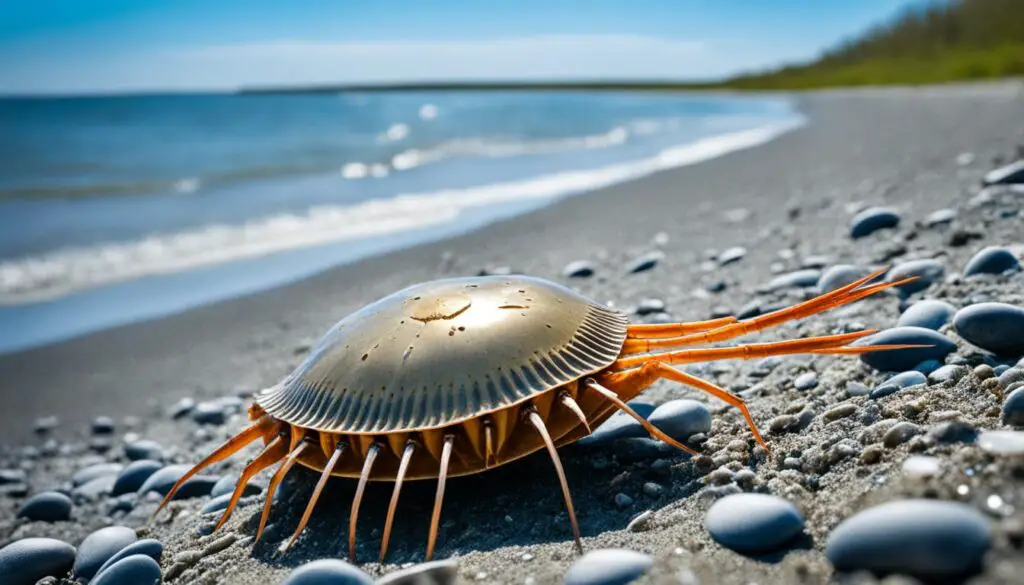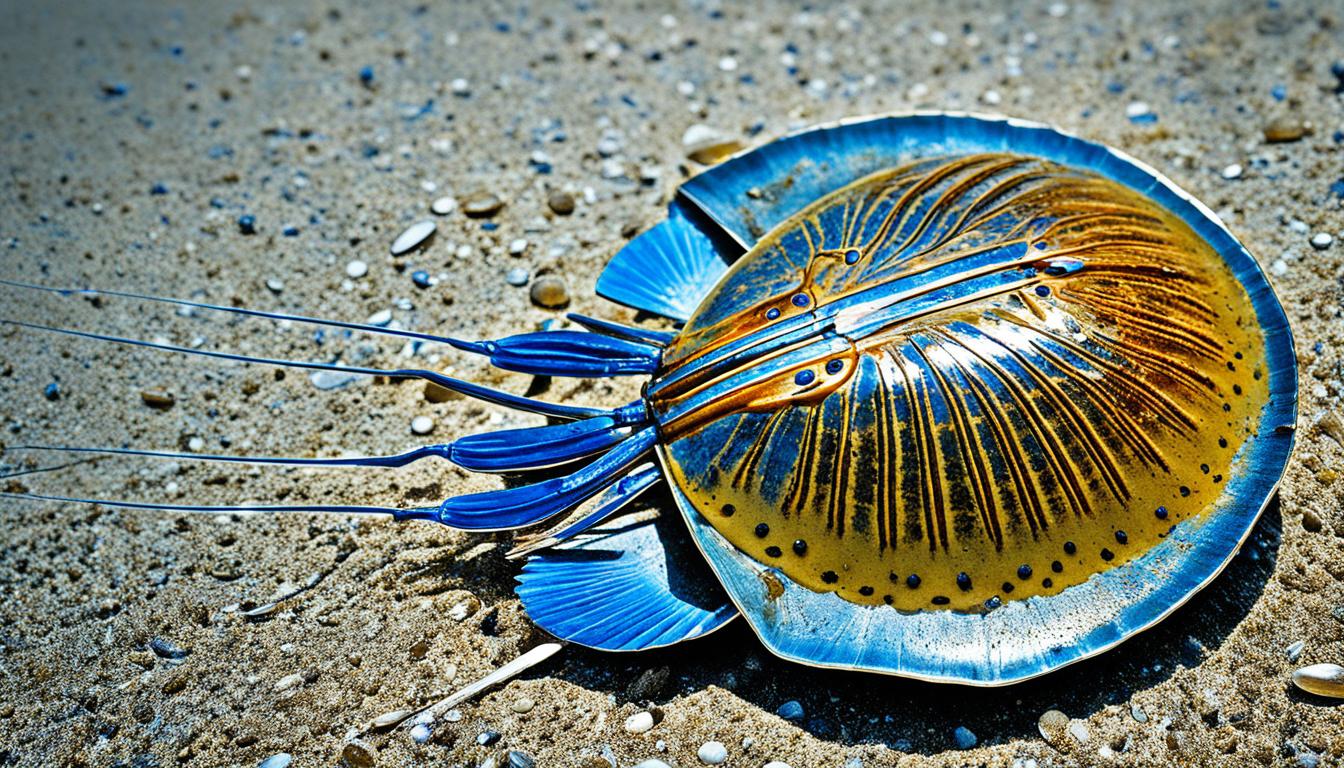Horseshoe crabs are key to medical research. Their blue blood is packed with a protein called Limulus Amebocyte Lysate (LAL). This protein is vital for checking for harmful bacteria in medicines and medical tools.
This helps keep patients safe and is a big step in fighting infections. As we look for safer and more effective treatments, horseshoe crabs are crucial. They help with vaccines, prosthetics, and intravenous drugs.
The Unique Properties of Horseshoe Crab Blood
Horseshoe crab blood has amazing properties that are key for medicine. Its special mix and certain parts make it very valuable in the biomedical world.
Composition of Horseshoe Crab Blood
The blood of horseshoe crabs looks blue-green because it has hemocyanin. This is a copper-based pigment that helps with breathing. Unlike human blood, which has iron-based hemoglobin, horseshoe crab blood has amebocytes as its main cells. These cells are crucial for how the blood works.
This special mix lets the blood quickly react to harmful bacteria. It can clot when it finds toxins.
Importance of Limulus Amebocyte Lysate (LAL)
Getting Limulus Amebocyte Lysate (LAL) from horseshoe crab blood is very important. LAL is key for finding endotoxin, which helps doctors check if products have harmful bacteria. Every year, over 80 million tests using LAL are done worldwide.
This shows how crucial horseshoe crab blood is for keeping medical devices and medicines safe. Without it, there would be a big risk of contamination in these products.
How are horseshoe crabs important to medical research?
Horseshoe crabs are vital in medical research. Their blood is key to the Limulus Amebocyte Lysate (LAL) test. This test checks for bacteria in medical products. It’s a must for the FDA to ensure vaccines and treatments are safe.
The pharmaceutical world depends on horseshoe crab blood for safety. This has led to more of these creatures being taken from the wild. While it helps medical progress, it worries about their numbers.
Finding a way to balance medical needs with horseshoe crab conservation is crucial. It’s interesting to see how these creatures play a part in making vaccines and treatments. This shows a deep link between science and nature.
The Role of Horseshoe Crabs in the Biomedical Industry
Horseshoe crabs play a huge role in the biomedical industry. They give us important resources for medical tests and safety checks. Their blood, especially Limulus Amebocyte Lysate (LAL), is key for making sure products are safe and work well, especially for drug companies.
Demand from Pharmaceutical Companies
Pharmaceutical companies need horseshoe crabs for LAL, which is vital for testing products for endotoxins. The demand has gone up because of the need for safe products. With more new medicines and vaccines being made, we need more horseshoe crab blood. This has made it important to harvest them in a way that protects their numbers while helping the industry.
Impact on Medical Advancements
Horseshoe crabs do more than just give blood. Their special properties help make vaccines and antibiotics safe. This shows how important they are for our health. As scientists work on making synthetic LAL, new innovations are coming along. These could lessen our need for natural resources but keep medical tests reliable.

Conservation Efforts and Sustainable Harvesting
Horseshoe crab populations face threats from overharvesting for biomedical uses and fishing bait. This shows the need for strong conservation efforts. By supporting effective management, you can help protect these creatures and meet biomedical industry needs.
Challenges in Horseshoe Crab Populations
Studies show horseshoe crab numbers are going down, making quick action necessary. Overharvesting, especially during breeding times, harms their ability to reproduce and their health. Understanding this helps us balance human needs with nature’s well-being.
Best Management Practices for Bleeding
New guidelines aim to improve how we bleed horseshoe crabs. These methods reduce stress and help more crabs survive after being taken from the wild. Sadly, about 15% of crabs don’t make it back.
It’s vital for the industry to use sustainable methods. Groups like the Horseshoe Crab Recovery Coalition are leading the way. Supporting them helps both horseshoe crabs and biomedical research.
FAQ
What is the significance of horseshoe crabs in medical research?
Horseshoe crabs are key in medical research because of their special blue blood. This blood contains Limulus Amebocyte Lysate (LAL). LAL is crucial for checking for bacterial toxins in medicines and medical tools. This ensures patients stay safe and keeps medical care standards high.
How does horseshoe crab blood contribute to endotoxin detection?
Horseshoe crab blood is essential because it has amebocytes that react to bacterial toxins. This reaction is used in the LAL test. The FDA requires this test for all medical products meant for injections. It helps protect public health.
Why is the demand for horseshoe crab blood increasing?
More horseshoe crab blood is needed because pharmaceutical companies want reliable ways to check for toxins. They use LAL testing to make sure vaccines and antibiotics are safe. This shows how important horseshoe crabs are in the biomedical field.
What are the challenges faced by horseshoe crab populations?
Horseshoe crabs are facing big challenges because they are taken too much for biomedical uses and as bait. This overuse is bad for their survival and their role in nature.
What conservation efforts are being made to protect horseshoe crabs?
Conservation efforts aim to make harvesting better to help more crabs survive. There are rules in place to lessen stress and death rates during blood collection.
What is Limulus Amebocyte Lysate (LAL) and its medical importance?
Limulus Amebocyte Lysate (LAL) comes from horseshoe crab blood and is used a lot to check if medical products are clean. It’s crucial in the biomedical world. It makes sure medical devices and medicines don’t have harmful germs.
How does the biomedical industry influence horseshoe crab conservation?
The need for horseshoe crab blood for LAL testing puts pressure on both the biomedical industry and crab conservation. It’s important to harvest crabs in a way that’s sustainable. Also, finding synthetic alternatives is key to meeting both needs.
Source Links
- https://www.npr.org/2023/06/10/1180761446/coastal-biomedical-labs-are-bleeding-more-horseshoe-crabs-with-little-accountabi
- https://www.pbs.org/newshour/science/blue-blood-from-horseshoe-crabs-is-needed-for-medicine-but-a-declining-bird-species-relies-on-the-crabs-to-eat
- https://dnr.maryland.gov/ccs/Pages/horseshoecrab-medical.aspx







